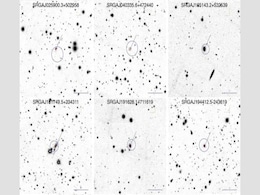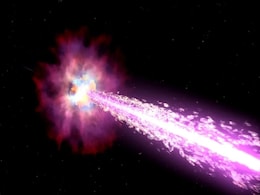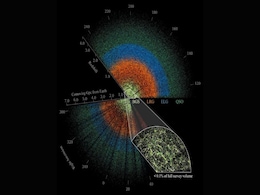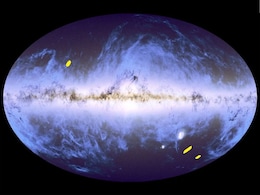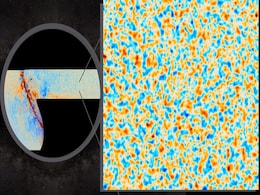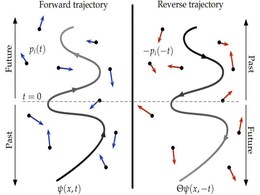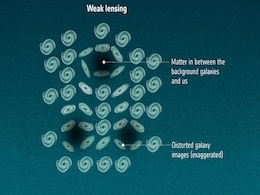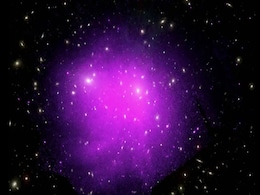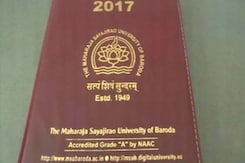Cosmology
- All
- News
- Videos
-

Padma Vibhushan Astrophysicist Jayant Narlikar Dies At 87
- Tuesday May 20, 2025
- India News | Press Trust of India
Jayant Vishnu Narlikar was widely known for his pioneering contributions to cosmology, his efforts to popularise science, and for setting up premier research institutions in the country.
-
 www.ndtv.com
www.ndtv.com
-

Russian Researchers Discover 11 New Active Galactic Nuclei In Spektr-RG X-ray Survey
- Saturday May 17, 2025
- Written by Gadgets 360 Staff
In a significant step for extragalactic astronomy, researchers from the Russian Academy of Sciences have identified 11 new active galactic nuclei (AGNs) through the ART-XC telescope aboard the Spektr-RG space observatory. These AGNs, classified as Seyfert galaxies, span redshifts from 0.028 to 0.258 and display X-ray luminosities typical for the pr...
-
 www.gadgets360.com
www.gadgets360.com
-

New Study Finds Hercules-Corona Borealis Great Wall Bigger and Nearer Than Thought
- Wednesday April 23, 2025
- Written by Gadgets 360 Staff
GRBs uncover a more massive and closer Hercules–Corona Borealis Great Wall, reshaping cosmic scale theories.Astronomers have found that the Hercules–Corona Borealis Great Wall—the largest known structure in the universe—is even larger and closer than previously thought. Spanning 10 billion light-years, this immense cluster of galaxies was t...
-
 www.gadgets360.com
www.gadgets360.com
-

Dark Energy May Not Be Constant - How This Discovery Can Change Science
- Friday April 4, 2025
- World News | The Conversation
The great Russian physicist and Nobel laureate Lev Landau once remarked that "cosmologists are often in error, but never in doubt". In studying the history of the universe itself, there is always a chance that we have got it all wrong.
-
 www.ndtv.com
www.ndtv.com
-

Did Black Hole Radiation Shape the Universe?
- Saturday March 29, 2025
- Written by Gadgets 360 Staff
A study suggests that Hawking radiation, first proposed by Stephen Hawking, may have influenced the universe’s structure. According to reports, primordial black holes that existed in the early universe could have evaporated through Hawking radiation, impacting matter distribution. The research explores how these black holes might have shaped gala...
-
 www.gadgets360.com
www.gadgets360.com
-

New Research Suggests Dark Energy Is Evolving, Challenging Cosmology Models
- Wednesday March 26, 2025
- Written by Gadgets 360 Staff
New research from the DESI project suggests that dark energy, once thought to be a constant force, may actually be changing over time. This challenges long-held cosmological models that assume a stable influence of dark energy on the universe’s expansion. By mapping 15 million galaxies, DESI’s data raises new questions about cosmic evolution. S...
-
 www.gadgets360.com
www.gadgets360.com
-

ESA’s Euclid Telescope Releases First Data, Mapping 26 Million Galaxies
- Wednesday March 26, 2025
- Written by Gadgets 360 Staff
ESA’s Euclid telescope has released its first dataset, mapping 26 million galaxies within a week. The observations include deep-field images, a survey of 380,000 galaxies, and 500 new gravitational lens candidates. Scientists will continue tracking cosmic evolution over six years. The dataset, currently 35 terabytes, is expected to grow to 2 peta...
-
 www.gadgets360.com
www.gadgets360.com
-

Atacama Telescope Reveals Most Detailed Cosmic Microwave Background Yet
- Thursday March 20, 2025
- Written by Gadgets 360 Staff
New images from the decommissioned Atacama Cosmology Telescope offer the most detailed view of the cosmic microwave background. The data reveals early cosmic structures, tracks primordial gas movement, and refines estimates of the universe’s total mass. While supporting existing models, it does not resolve the Hubble tension. Researchers are now ...
-
 www.gadgets360.com
www.gadgets360.com
-

Frontier Supercomputer Simulates Universe with Unmatched Complexity
- Tuesday February 18, 2025
- Written by Gadgets 360 Staff
The Frontier supercomputer at Oak Ridge National Laboratory has conducted the most detailed universe simulation to date. Using the Hardware/Hybrid Accelerated Cosmology Code (HACC) under the U.S. Department of Energy’s Exascale Computing Project, the model incorporates dark matter, gas, and plasma interactions. With speeds reaching 1.4 exaFLOPS, ...
-
 www.gadgets360.com
www.gadgets360.com
-

Quantum Research Reveals Time May Not Always Move Forward
- Friday February 14, 2025
- Written by Gadgets 360 Staff
A new study on quantum systems suggests time might not always move forward. Researchers found that time-reversal symmetry persists in open quantum systems, challenging the traditional notion of a single directional arrow of time. The mathematical framework behind these interactions indicates that fundamental equations do not impose a distinction be...
-
 www.gadgets360.com
www.gadgets360.com
-

Weak Gravitational Lensing Examines Universe’s Structure: What You Need to Know
- Thursday February 13, 2025
- Written by Gadgets 360 Staff
The universe's large-scale uniformity is under scrutiny through weak gravitational lensing. Researchers are analysing data from the Euclid Space Telescope to detect potential anisotropies in cosmic expansion. If confirmed, these findings could challenge the fundamental Cosmological Principle, which assumes the universe has no preferred direction. T...
-
 www.gadgets360.com
www.gadgets360.com
-

New Cosmic Surveys Reveal Unexpected Clues About Universe’s Evolution
- Monday February 3, 2025
- Written by Gadgets 360 Staff
A new study published in the Journal of Cosmology and Astroparticle Physics reveals a potential discrepancy in the expected clumpiness of cosmic structures. Researchers from the University of Pennsylvania and Lawrence Berkeley National Laboratory analysed data from the Atacama Cosmology Telescope (ACT) and the Dark Energy Spectroscopic Instrument (...
-
 www.gadgets360.com
www.gadgets360.com
-

Scientists Discover Hidden Clues to the Dark Universe in 3D Galaxy Maps
- Thursday January 30, 2025
- Written by Gadgets 360 Staff
A breakthrough study has revealed new insights into the "dark universe," which consists of dark matter and dark energy. By using a novel technique called field-level inference (FLI), scientists have discovered previously hidden details in 3D galaxy maps. This method preserves the three-dimensional nature of the data, unlike traditional compression ...
-
 www.gadgets360.com
www.gadgets360.com
-

Coma Cluster’s Distance Closer Than Predicted, Amplifying Hubble Tension Crisis
- Friday January 24, 2025
- Written by Gadgets 360 Staff
A new study led by Dan Scolnic and Adam Riess reveals that the Coma Cluster is 38 million light-years closer than predicted by standard cosmological models, intensifying the ongoing Hubble tension. This discrepancy, involving measurements of type Ia supernova explosions, challenges the universe's expansion rate as predicted by the Hubble–Lemaîtr...
-
 www.gadgets360.com
www.gadgets360.com
-

New Study Uncovers Discrepancies in Universe’s Expansion Rate, Challenges Cosmology Models
- Wednesday January 22, 2025
- Written by Gadgets 360 Staff
A recent study has revealed inconsistencies in the universe's expansion rate, further challenging established cosmological models. Measurements from the Hubble Space Telescope, James Webb Space Telescope, and the Dark Energy Spectroscopic Instrument (DESI) indicate that the universe is expanding at varying speeds. This discrepancy raises critical q...
-
 www.gadgets360.com
www.gadgets360.com
-

Padma Vibhushan Astrophysicist Jayant Narlikar Dies At 87
- Tuesday May 20, 2025
- India News | Press Trust of India
Jayant Vishnu Narlikar was widely known for his pioneering contributions to cosmology, his efforts to popularise science, and for setting up premier research institutions in the country.
-
 www.ndtv.com
www.ndtv.com
-

Russian Researchers Discover 11 New Active Galactic Nuclei In Spektr-RG X-ray Survey
- Saturday May 17, 2025
- Written by Gadgets 360 Staff
In a significant step for extragalactic astronomy, researchers from the Russian Academy of Sciences have identified 11 new active galactic nuclei (AGNs) through the ART-XC telescope aboard the Spektr-RG space observatory. These AGNs, classified as Seyfert galaxies, span redshifts from 0.028 to 0.258 and display X-ray luminosities typical for the pr...
-
 www.gadgets360.com
www.gadgets360.com
-

New Study Finds Hercules-Corona Borealis Great Wall Bigger and Nearer Than Thought
- Wednesday April 23, 2025
- Written by Gadgets 360 Staff
GRBs uncover a more massive and closer Hercules–Corona Borealis Great Wall, reshaping cosmic scale theories.Astronomers have found that the Hercules–Corona Borealis Great Wall—the largest known structure in the universe—is even larger and closer than previously thought. Spanning 10 billion light-years, this immense cluster of galaxies was t...
-
 www.gadgets360.com
www.gadgets360.com
-

Dark Energy May Not Be Constant - How This Discovery Can Change Science
- Friday April 4, 2025
- World News | The Conversation
The great Russian physicist and Nobel laureate Lev Landau once remarked that "cosmologists are often in error, but never in doubt". In studying the history of the universe itself, there is always a chance that we have got it all wrong.
-
 www.ndtv.com
www.ndtv.com
-

Did Black Hole Radiation Shape the Universe?
- Saturday March 29, 2025
- Written by Gadgets 360 Staff
A study suggests that Hawking radiation, first proposed by Stephen Hawking, may have influenced the universe’s structure. According to reports, primordial black holes that existed in the early universe could have evaporated through Hawking radiation, impacting matter distribution. The research explores how these black holes might have shaped gala...
-
 www.gadgets360.com
www.gadgets360.com
-

New Research Suggests Dark Energy Is Evolving, Challenging Cosmology Models
- Wednesday March 26, 2025
- Written by Gadgets 360 Staff
New research from the DESI project suggests that dark energy, once thought to be a constant force, may actually be changing over time. This challenges long-held cosmological models that assume a stable influence of dark energy on the universe’s expansion. By mapping 15 million galaxies, DESI’s data raises new questions about cosmic evolution. S...
-
 www.gadgets360.com
www.gadgets360.com
-

ESA’s Euclid Telescope Releases First Data, Mapping 26 Million Galaxies
- Wednesday March 26, 2025
- Written by Gadgets 360 Staff
ESA’s Euclid telescope has released its first dataset, mapping 26 million galaxies within a week. The observations include deep-field images, a survey of 380,000 galaxies, and 500 new gravitational lens candidates. Scientists will continue tracking cosmic evolution over six years. The dataset, currently 35 terabytes, is expected to grow to 2 peta...
-
 www.gadgets360.com
www.gadgets360.com
-

Atacama Telescope Reveals Most Detailed Cosmic Microwave Background Yet
- Thursday March 20, 2025
- Written by Gadgets 360 Staff
New images from the decommissioned Atacama Cosmology Telescope offer the most detailed view of the cosmic microwave background. The data reveals early cosmic structures, tracks primordial gas movement, and refines estimates of the universe’s total mass. While supporting existing models, it does not resolve the Hubble tension. Researchers are now ...
-
 www.gadgets360.com
www.gadgets360.com
-

Frontier Supercomputer Simulates Universe with Unmatched Complexity
- Tuesday February 18, 2025
- Written by Gadgets 360 Staff
The Frontier supercomputer at Oak Ridge National Laboratory has conducted the most detailed universe simulation to date. Using the Hardware/Hybrid Accelerated Cosmology Code (HACC) under the U.S. Department of Energy’s Exascale Computing Project, the model incorporates dark matter, gas, and plasma interactions. With speeds reaching 1.4 exaFLOPS, ...
-
 www.gadgets360.com
www.gadgets360.com
-

Quantum Research Reveals Time May Not Always Move Forward
- Friday February 14, 2025
- Written by Gadgets 360 Staff
A new study on quantum systems suggests time might not always move forward. Researchers found that time-reversal symmetry persists in open quantum systems, challenging the traditional notion of a single directional arrow of time. The mathematical framework behind these interactions indicates that fundamental equations do not impose a distinction be...
-
 www.gadgets360.com
www.gadgets360.com
-

Weak Gravitational Lensing Examines Universe’s Structure: What You Need to Know
- Thursday February 13, 2025
- Written by Gadgets 360 Staff
The universe's large-scale uniformity is under scrutiny through weak gravitational lensing. Researchers are analysing data from the Euclid Space Telescope to detect potential anisotropies in cosmic expansion. If confirmed, these findings could challenge the fundamental Cosmological Principle, which assumes the universe has no preferred direction. T...
-
 www.gadgets360.com
www.gadgets360.com
-

New Cosmic Surveys Reveal Unexpected Clues About Universe’s Evolution
- Monday February 3, 2025
- Written by Gadgets 360 Staff
A new study published in the Journal of Cosmology and Astroparticle Physics reveals a potential discrepancy in the expected clumpiness of cosmic structures. Researchers from the University of Pennsylvania and Lawrence Berkeley National Laboratory analysed data from the Atacama Cosmology Telescope (ACT) and the Dark Energy Spectroscopic Instrument (...
-
 www.gadgets360.com
www.gadgets360.com
-

Scientists Discover Hidden Clues to the Dark Universe in 3D Galaxy Maps
- Thursday January 30, 2025
- Written by Gadgets 360 Staff
A breakthrough study has revealed new insights into the "dark universe," which consists of dark matter and dark energy. By using a novel technique called field-level inference (FLI), scientists have discovered previously hidden details in 3D galaxy maps. This method preserves the three-dimensional nature of the data, unlike traditional compression ...
-
 www.gadgets360.com
www.gadgets360.com
-

Coma Cluster’s Distance Closer Than Predicted, Amplifying Hubble Tension Crisis
- Friday January 24, 2025
- Written by Gadgets 360 Staff
A new study led by Dan Scolnic and Adam Riess reveals that the Coma Cluster is 38 million light-years closer than predicted by standard cosmological models, intensifying the ongoing Hubble tension. This discrepancy, involving measurements of type Ia supernova explosions, challenges the universe's expansion rate as predicted by the Hubble–Lemaîtr...
-
 www.gadgets360.com
www.gadgets360.com
-

New Study Uncovers Discrepancies in Universe’s Expansion Rate, Challenges Cosmology Models
- Wednesday January 22, 2025
- Written by Gadgets 360 Staff
A recent study has revealed inconsistencies in the universe's expansion rate, further challenging established cosmological models. Measurements from the Hubble Space Telescope, James Webb Space Telescope, and the Dark Energy Spectroscopic Instrument (DESI) indicate that the universe is expanding at varying speeds. This discrepancy raises critical q...
-
 www.gadgets360.com
www.gadgets360.com


